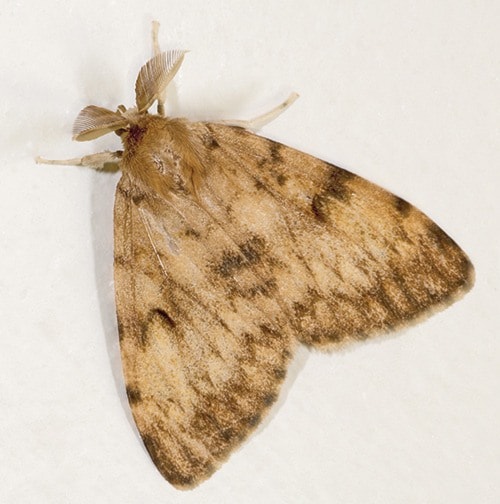Forest Health Officer with the Ministry of Forests, Lands and Natural Resource Operations in Victoria, Tim Ebata discussed the aerial spray program for eradicating the Gypsy moth at Elk Lake and Bear Hill come early spring.
Ebata, who’s been working with the Gypsy moth program since 1998, discussed the upcoming spray treatment, why they’re doing the treatment in the Elk Lake Area (bordering Central Saanich), public concerns and next steps.
“Gypsy moth is a well established insect pest. It was an invasive species brought in from France,” said Ebata.
The Gypsy moth is established solidly in eastern North America and has had outbreaks in Ontario and Quebec.
“The spread is very slow, the female is flightless, but the main movement method for long distance travel is the movement of egg masses,” he said.
The female, he said, will lay its egg masses on any solid surface that may be out, but if those are moved from one location to another, the egg masses will move with them and hatch, starting a new population.
“The main monitoring agency is the Canadian Food Inspection Agency, the federal agency.
“They monitor for Gypsy moth all across Canada and they put (out) about 5,000 traps,” he said, adding that they’re mainly looking for the Asian Gypsy moth but do monitor for European Gypsy moth.
Closer to home, the Gypsy moth are found south of Central Saanich, right on the border at Bear Hill Park, and according to Ebata, it’s a population that’s been growing.
“We found one moth in 2014, three in 2015 and 14 in a concentrated area in 2016.”
They also looked for egg masses, he said, to see if there was evidence of a brooding population, which there is. So their committee has decided that is a treatable area.
“This insect is a major feeder of over 300 different trees and shrubs. Many of them are common commercial species as well as ornamental species,” he said.
The negative effects on these species is that each caterpillar can eat up to 100 square centimeters of foliage, which Ebata said is a lot of leaves for one caterpillar.
“Outbreaks in eastern Canada are brutal. It looks like it’s fall in the middle of the summer ...”
The moth does, however, cause possible trade implications in terms of quarantines and added inspection requirements for goods that are identified as potential movers of egg masses — such as nursery stocks and logs with bark.
The plan is for applications of the bacterial insecticide called Foray 48b (Btk) at four liters per hectare to be applied in the early spring by an airplane.
There would be three applications, seven days apart beginning in April.
Ebata said Central Saanich, which is right on the north border of the treatment block, is where potential drift of the chemical could occur.
“The plane will fly over the spray area and then turn, so there’s going to be a larger affected area...” he said.
The aircraft will cross into Central Saanich and Saanich, in the vicinity of the Pat Bay Highway.
There have been public concerns, Ebata noted, organic certification being a big one, along with noise, health risks and impacts on non-target organisms.
Originally, Btk was deemed suitable for certified organic farms but then OMRI Canada, a certification body for organic farms, declared they haven’t approved the product yet.
“It’s a new issue that’s showed up,” said Ebata, adding that he’s working with the Ministry of Agriculture to deal with the issue.
Ebata said they have reached out to one farm over those specific concerns.
Ebata said the government is waiting for the permit to be issued. Advertising the spray activity via flyers plus using electric signs on the Pat Bay to let people know, will lead up to the spray, once it’s approved.
The information will be forwarded to the Peninsula and Area Agricultural Advisory Committee.
